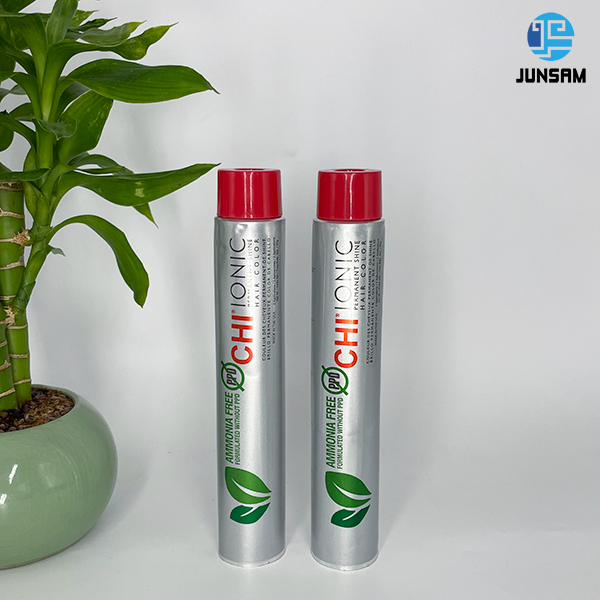Choosing the right packaging for hair color cream for hair dyeing brands is vital for product quality, customer satisfaction, and brand reputation. Hair color tubes, typically made of aluminum or plastic, offer unique advantages and drawbacks. This guide aims to provide hair dyeing brands with the necessary insights to select the most suitable hair color tubes, balancing performance, consumer preferences, and environmental considerations.
Advantages of Aluminum Hair Color Tubes
Duurzaamheid en bescherming
Aluminum tubes provide excellent protection for hair color creams, preserving the product’s integrity by preventing contamination and degradation:
- Barrière-eigenschappen: Aluminum is impervious to light, air, and moisture, significantly extending the shelf life of hair color products.
- Strength and Resilience: Its sturdy nature ensures the tube remains intact under pressure, preventing leaks and spills during transportation and storage.
Sustainability and Environmental Impact
Aluminum’s recyclability makes it a preferred choice for environmentally conscious brands:
- Recyclability: Aluminum can be recycled infinitely without losing quality, reducing environmental footprint.
- Consumer Perception: Brands can leverage the sustainability aspect of aluminum to attract eco-conscious consumers, enhancing brand image.
Aesthetic and Branding Opportunities
Aluminum tubes offer premium aesthetics that can enhance product appeal:
- Premium Look and Feel: The sleek, metallic finish of aluminum tubes can position a brand as high-end and professional.
- Customization Options: Aluminum allows for high-quality printing and various finishing options, such as matte or gloss, to reflect brand identity.
Advantages of Plastic Hair Color Tubes
Kosten efficiëntie
Plastic tubes are often more affordable to produce compared to aluminum, offering cost savings:
- Lower Production Costs: The manufacturing process for plastic tubes is generally cheap, which can benefit brands operating on a tight budget.
- Economical for Bulk Production: Plastic is ideal for producing large quantities without significantly increasing expenses.
Flexibility and Usability
Plastic tubes are valued for their versatility and ease of use:
- Flexible and Squeezable: Plastic tubes are easy to squeeze, allowing consumers to dispense the product effortlessly.
- Lightweight: The lightweight nature of plastic reduces shipping costs and enhances consumer convenience.
Customization and Design Flexibility
Plastic provides greater flexibility in design and branding:
- Variety of Shapes and Sizes: Plastic tubes can be molded into various shapes and sizes, catering to different consumer needs and preferences.
- Vivid Printing: High-definition printing options on plastic tubes enable vibrant and eye-catching designs.
Shortcomings of Aluminum Hair Color Tubes
Limited Design Flexibility
While aluminum offers a premium look, it’s less flexible than plastic in terms of design:
- Rigid Structure: Aluminum’s rigidity limits its shape and size configurations, potentially restricting branding opportunities.
- Printing Limitations: Although premium in appearance, aluminum may not support the same range of vibrant colors as plastic.
Shortcomings of Plastic Hair Color Tubes
Environmental Concerns
Plastic usage poses significant environmental challenges:
- Non-Biodegradable: Traditional plastic tubes contribute to landfill waste and environmental pollution.
- Consumer Backlash: Increasing consumer awareness and preference for sustainable products can lead to negative perceptions of plastic packaging.
Durability and Protection by different types of hair color tubes
Plastic tubes may not offer the same level of product protection as aluminum:
- Less Effective Barrier: Plastic is more permeable to light and air, which can reduce the shelf life of the enclosed product.
- Potential for Breakage: Plastic tubes are more prone to cracks and leaks, especially under extreme conditions.
Evaluating Based on Brand Objectives
Market Positioning
Brands need to align their packaging choices with their market positioning:
- Premium Brands: High-end brands may prefer aluminum tubes for their durability and premium appearance.
- Mass Market Brands: Brands targeting price-sensitive consumers might use plastic tubes to decrease costs.
Consumer Preferences
Understanding target consumer preferences can guide packaging decisions:
- Eco-Conscious Consumers: Brands targeting environmentally savvy consumers might choose aluminum for its recyclability and lower environmental impact.
- Convenience-Oriented Consumers: Plastic’s flexibility can be a deciding factor for consumers who prioritize ease of use.
Product Type and Formulation
The nature of the hair color product itself can influence packaging decisions:
- Sensitive Formulations: Products with sensitive ingredients that degrade easily may benefit more from the protective properties of aluminum.
- Everyday Use Formulations: Plastic’s flexibility and practicality can be advantageous for products designed for frequent use.
Conclusie
Choosing the right hair color tube packaging involves weighing the advantages and disadvantages of both aluminum and plastic materials. Aluminum offers superior durability, protection, and an eco-friendly profile, making it ideal for premium and environmentally-conscious brands. On the other hand, plastic provides design flexibility and ease of use, suiting mass-market brands and everyday consumer products. By considering factors such as market positioning, consumer preferences, and product formulation, hair dyeing brands can make an informed decision that aligns with their objectives and meets their customers’ needs.


